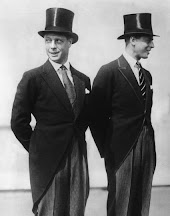The Martello Tower
In Sydney harbour modernity towers over Fort Denison, Australia's only Martello, and probably the last such Martello built by the British Empire during the 19th century. This small round defensive fort, equipped with a garrison of 25 men and one or two rotating cannon on the top floor, would have been useful at one time to protect the New South Wales' settlement from naval broadsides. Though laughably obsolete today, and even more laughable to call it one of Sydney's towers, it would be prudent to believe that over the next thousand years the original thick stone walls of the old Martello tower will probably still be there, unlike the mocking piles of glass above it. Construction used 8,000 tonnes of sandstone from nearby Kurraba Point, Neutral Bay. Walls in the tower are between 3.3 meters and 6.7 meters thick at the base and 2.7 meters thick at the top. It's construction was intended to protect the settlement from Russian attack during the Crimean War.
Construction used 8,000 tonnes of sandstone from nearby Kurraba Point, Neutral Bay. Walls in the tower are between 3.3 meters and 6.7 meters thick at the base and 2.7 meters thick at the top. It's construction was intended to protect the settlement from Russian attack during the Crimean War. Between 1804 and 1812 the British authorities, first under William Pitt the Younger, built a chain of similar structures to defend the south and east coast of England, Ireland, Jersey and Guernsey against possible invasion from Napoleonic France. 105 were built in the British Isles, set at intervals along the coast from Seaford, Sussex, to Aldeburgh, Suffolk. Most were constructed under the direction of General William Twiss (1745–1827).
Between 1804 and 1812 the British authorities, first under William Pitt the Younger, built a chain of similar structures to defend the south and east coast of England, Ireland, Jersey and Guernsey against possible invasion from Napoleonic France. 105 were built in the British Isles, set at intervals along the coast from Seaford, Sussex, to Aldeburgh, Suffolk. Most were constructed under the direction of General William Twiss (1745–1827).  "One man's obsession with Martello Towers has resulted in this detailed website"
"One man's obsession with Martello Towers has resulted in this detailed website"
The name Martello (and the idea for the English towers) came from a circular stone tower built in Corsica [see photo below], at Mortella Point. French troops occupied the island, and so Corsican patriots pleaded for British help to drive the French out. In 1794, two Royal Navy ships sailed close to the Mortella Tower to destroy it, but were themselves fired upon, suffering sixty casualties. The tower eventually had to be captured by the army, but its strength had impressed those whose efforts it had stoutly resisted for several days.
 A total of sixteen Martello towers were built in Canada, of which eleven are still standing. No less than four were built at Kingston, Ontario alone to defend its harbour and naval shipyards from American attack (the one below now houses the Royal Military College Museum at Fort Frederick). Seven Martellos were also built along the east coast of the United States, whose designs, for the most part, were copied from the towers erected in Canada by the British.
A total of sixteen Martello towers were built in Canada, of which eleven are still standing. No less than four were built at Kingston, Ontario alone to defend its harbour and naval shipyards from American attack (the one below now houses the Royal Military College Museum at Fort Frederick). Seven Martellos were also built along the east coast of the United States, whose designs, for the most part, were copied from the towers erected in Canada by the British. Perhaps the most famous Martello is the James Joyce Tower in Ireland, which currently stands as a museum housing Joyce's life and works. All in all, the Martello Tower is a surviving reminder of Britain's rich imperial heritage.
Perhaps the most famous Martello is the James Joyce Tower in Ireland, which currently stands as a museum housing Joyce's life and works. All in all, the Martello Tower is a surviving reminder of Britain's rich imperial heritage.
 Vice-Regal Saint:
Vice-Regal Saint: 








































.gif)

.gif)















































































































10 comments:
Interesting post. As you are aware, there are a few Martello Towers on the south coast if England
I'm well acquainted with the Martello Towers, having grown up in Kingston. Quite interesting fortifications, especially given the time span in which they were built.
Alexander Mackenzie, our second Prime Minister, was one of the master stonemasons during the construction of Kingston's Martello towers.
Right you are, Kipling, and likely the reason why he chose that location for the Royal Military College.
The English coastline is just littered with them, a reminder of the palpable fear that raged through England during the Napoleonic Wars.
An interesting study, but I object to the derision of the modern towers! Well, not so seriously, but regardless of how glass-like the towers in the Sydney skyline look, they're actually quite the feats of steel and concrete engineering. They may not look the same in a 1000 years, and they may not all be there, but some, I strongly suspect, will still be standing (barring any massive disaster).
They may be standing, but it's hard to imagine they would be with the original glass. What is the useful life of glass against the elements, anyways? (I do suppose there are a lot of beautiful cathedral stained windows that have stood the test of time)
One of the Martello Towers built in Kingston, Ontario was named after my ancestor who came to Canada, Captain Henry James Murney.
Murney Tower is a museum today in Kingston.
Thanks, John. Interesting.
"Rich imperial heritage"... a lot of cultures which had this heritage imposed upon them might question it's richness.
Post a Comment